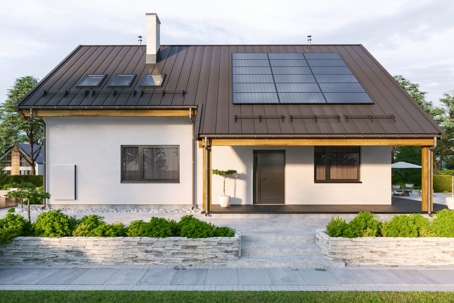A Guide for Homeowners
As climate change and rising utility costs remain prominent issues, homeowners with solar PV systems are looking for ways to reduce their carbon footprint even further. One solution that has gained popularity in recent years is using solar backup batteries. These batteries are designed to store solar energy for later use, making them an essential tool for homeowners who want to increase energy independence and reduce their reliance on the grid.
In this blog, we will explore the components of a solar backup battery system and the benefits of having one installed.
How Solar Backup Batteries Work
Before we dive into the components of a solar backup battery system, it's important to know how they work. Solar panels convert sunlight into direct current (DC) electricity, which is then sent to an inverter. The inverter converts the DC electricity into alternating current (AC) electricity, which powers your home. The excess energy produced is then stored in a battery, which can be used later when the sun isn't shining.
Here's a step-by-step explanation of how solar backup batteries work:
- Solar panel energy generation: Solar panels absorb sunlight and convert it into direct current electricity through the photovoltaic effect.
- Power conversion: The DC electricity generated by the solar panels is then sent to an inverter, which converts it into alternating current electricity. AC electricity is compatible with most household appliances and the electrical grid.
- Energy distribution: The AC electricity is then distributed throughout your home. If your solar power system is connected to the grid, any excess electricity not used by your home can be sent back to the grid for credit or compensation, depending on your location and utility policies.
- Battery charging: When your solar panels generate more electricity than your home needs, the excess energy is used to charge your solar backup battery. The battery's charge controller manages this process to ensure the battery is charged efficiently and safely.
- Energy storage: The solar backup battery stores the excess energy as chemical potential energy within its cells. The most common types of batteries used in solar power systems are lead-acid and lithium-ion batteries, each with their own advantages and disadvantages.
- Discharging stored energy: When your solar panels are not producing enough electricity to meet your home's energy needs, such as at night or during cloudy weather, the solar backup battery supplies the stored energy to your home. The inverter converts the DC electricity from the battery into AC electricity for your appliances.
- Monitoring and maintenance: Solar backup battery systems usually come with monitoring software that allows you to track your energy generation, consumption and battery status. Regular maintenance, such as cleaning the solar panels and checking the battery connections, helps ensure optimal performance and extends the lifespan of the system.
How Much Does a Solar Backup Batter Cost?
The total cost of installing a solar backup battery can vary depending on several factors, such as the type of battery, its size and power, installation costs and any additional equipment needed. The average cost can range from several hundred dollars per battery to several thousand. Lead-acid batteries are generally less expensive, while lithium-ion batteries are more expensive.
However, you should not pick your backup battery solely based on its sticker price. While one option may have a lower initial cost, some more expensive lithium-ion options are longer-lasting and more efficient. This can save you significantly in the long run. Remember, the cost of a solar backup battery is an investment in your home's long-term energy independence.
To get a detailed estimate of your backup battery system options and pricing, contact Valley Heating, Cooling, Electrical and Solar.

